Finite Element Analysis of Flexural Behavior of Shape Memory Alloy Hybrid Composites Laminates
Abstract
1. Introduction
2. Experimental and Numerical Simulation
2.1. Materials
2.2. Three-Point-Bending Tests
2.3. Finite Element Modeling
3. Results and Discussion
3.1. Experimental Results
3.2. Numerical Results
4. Conclusions
- The optimal number of SMA wires for SMAHC laminates (B-2) is four. Compared with GFRP laminates, the flexural modulus of B-2-4 laminates increases by 5.19%, while the strength decreases by 5.76% on average. The flexural properties of B-2-6 and B-2-10 laminates decrease more obviously, and the weak interface between fiber and matrix is the main reason for the degradation of the flexural properties.
- The microstructure shows that the material difference between SMA and matrix forms a weak interface, which produces microcracks and expands rapidly during the loading process. The interface debonding failure results in matrix delamination and the final specimen failure. The weak interface between the matrix and SMA increases with the increase of the number of SMA wires, which is convenient for the formation of matrix delamination damage. The main failure modes of SMAHC composites are delamination and debonding, and this failure mode has an obvious influence on the mechanical properties of the composites.
- The finite element models of GFRP and SMAHC (B-2-4) laminates were established and compared with the experimental results. The numerical prediction results were in good agreement with the experimental results. The errors between the simulation results of GFRP laminates and the experimental results of flexural performance were 2.56% and 10.43%, respectively. The errors of experimental results and simulation results of the flexural performance of SMAHC laminates (B-2-4) are 4.38% and 2.34% respectively, which meet the accuracy requirements and verify the validity of the model.
Author Contributions
Funding
Institutional Review Board Statement
Data Availability Statement
Conflicts of Interest
References
- Bhaskar, J.; Sharma, A.K.; Bhattacharya, B.; Adhikari, S. A review on shape memory alloy reinforced polymer composite materials and structures. Smart. Mater. Struct. 2020, 29, 073001. [Google Scholar] [CrossRef]
- Bahl, S.; Nagar, H.; Singh, I.; Sehgal, S. Smart materials types, properties and applications: A review. Mater. Today. Proc. 2020, 28, 1302–1306. [Google Scholar] [CrossRef]
- Qiu, C.; Zhu, S. Shake table test and numerical study of self-centering steel frame with SMA braces. Earthq. Eng. Struct. D. 2017, 46, 117–137. [Google Scholar] [CrossRef]
- Wang, W.; Fang, C.; Liu, J. Large size superelastic SMA bars: Heat treatment strategy, mechanical property and seismic application. Smart. Mater. Struct. 2016, 25, 075001. [Google Scholar] [CrossRef]
- Hartl, D.J.; Lagoudas, D.C. Aerospace applications of shape memory alloys. P I Mech. Eng. G-J Aer. 2007, 221, 535–552. [Google Scholar] [CrossRef]
- Pattar, N.; Patil, S.F. Review on fabrication and mechanical characterization of shape memory alloy hybrid composites. Adv. Compos. Hybrid Mater. 2019, 2, 571–585. [Google Scholar] [CrossRef]
- Wang, W.Z.; Zhao, Y.R.; Chen, S.J.; Jin, X.C.; Fan, X.L.; Lu, C.S.; Yang, C.X. Low-velocity impact behaviors of glass fiber-reinforced polymer laminates embedded with shape memory alloy. Compos. Struct. 2021, 272, 114194. [Google Scholar] [CrossRef]
- Liu, Y.F.; Wang, Z.Q.; Li, H.; Sun, M.; Wang, F.X.; Chen, B.J. Influence of Embedding SMA Fibres and SMA Fibre Surface Modification on the Mechanical Performance of BFRP Composite Laminates. Materials. 2018, 11, 70. [Google Scholar] [CrossRef]
- Lagoudas, D.C.; Tadjbaksh, I.G. Active flexible rods with embedded SMA fibers. Smart. Mater. Struct. 1992, 1, 162–167. [Google Scholar] [CrossRef]
- Auricchio, F.; Morganti, S.; Reali, A.; Urbano, M. Theoretical and experimental study of the shape memory effect of beams in bending conditions. J. Mater. Eng. Perform. 2011, 20, 712–718. [Google Scholar] [CrossRef]
- Lal, A.; Markad, K. Static buckling analysis of shape memory alloy reinforced composite laminated plate. IOP Conf Ser: Mater. Sci. Eng. 2020, 814, 012009. [Google Scholar] [CrossRef]
- Lu, P.; Cui, F.S.; Tan, M.J. A theoretical model for the bending of a laminated beam with SMA fiber embedded layer. Compos. Struct. 2009, 90, 458–464. [Google Scholar] [CrossRef]
- Viet, N.V.; Zaki, W. Bending model for a laminated composite cantilever beam with multiple embedded shape memory alloy layers presenting tensile-compressive asymmetry. Compos. Struct. 2019, 229, 111410. [Google Scholar] [CrossRef]
- Tsukamoto, H. Mechanical behavior of shape memory alloy fiber reinforced aluminum matrix composites. Mater. Today Commun. 2021, 29, 102750. [Google Scholar] [CrossRef]
- Zhang, R.X.; Ni, Q.Q.; Natsuki, T.; Iwamoto, M. Mechanical properties of composites filled with SMA particles and short fibers. Compos Struct. 2007, 79, 90–96. [Google Scholar] [CrossRef]
- Viet, N.V.; Zaki, W. Modeling bending behavior of shape memory alloy wire-reinforced composites: Semi-analytical model and finite element analysis. Chin. J Aeronaut. 2021, 34, 176–191. [Google Scholar] [CrossRef]
- Viet, N.V.; Zaki, W.; Umer, R. Analytical model for a superelastic Timoshenko shape memory alloy beam subjected to a loading-unloading cycle. J. Intell. Mater. Syst. Struct. 2018, 29, 3902–3922. [Google Scholar] [CrossRef]
- Pattar, N.; Patil, S.F.; Patil, P.; Anikivi, I.; Hiremath, S. Evaluation of the Mechanical Properties of Glass/Epoxy Composite by Embedding Shape Memory Alloy and Nanoclay. Mater. Sci. Forum. 2021, 1019, 3–11. [Google Scholar] [CrossRef]
- Aslani, F.; Liu, Y.N.; Wang, Y. Flexural and toughness properties of NiTi shape memory alloy, polypropylene and steel fibres in self-compacting concrete. J. Intell. Mater. Syst. Struct. 2019, 31, 3–16. [Google Scholar] [CrossRef]
- Pazhanivel, K.; Bhaskar, G.B.; Elayaperumal, A.; Anandan, P.; Arunachalam, S. Influence of Ni-Ti shape memory alloy short fibers on the flexural response of glass fiber reinforced polymeric composites. SN Appl. Sci. 2019, 1, 789. [Google Scholar] [CrossRef]
- Katsiropoulos, C.V.; Pappas, P.; Koutroumanis, N.; Kokkinos, A.; Galiotis, C. Improving the damping behavior of fiber reinforced polymer composites with embedded superelastic shape memory alloys (SMA). Smart Mater. Struct. 2020, 29, 025006. [Google Scholar] [CrossRef]
- Taheri-Behrooz, F.; Mahdavizade, M.J.; Ostadrahimi, A. Micromechanics of stress transfer in shape memory alloy reinforced three-phase composites. J. Intell. Mater. Syst. Struct. 2018, 29, 3151–3164. [Google Scholar] [CrossRef]
- Khalili, S.; Khalili, S.M.R.; Farsani, R.E.; Mahajan, P. Flexural properties of sandwich composite panels with glass laminate aluminum reinforced epoxy facesheets strengthened by SMA wires. Polym. Test. 2020, 89, 106641. [Google Scholar] [CrossRef]
- Debski, H.; Rozylo, P.; Wysmulski, P.; Falkowicz, K.; Ferdynus, M. Experimental study on the effect of eccentric compressive load on the stability and load-carrying capacity of thin-walled composite profiles. Compos. Part B 2021, 226, 109346. [Google Scholar] [CrossRef]
- Wysmulski, P.; Debski, H.; Falkowicz, K. Sensitivity of Compressed Composite Channel Columns to Eccentric Loading. Mater. 2022, 15, 6938. [Google Scholar] [CrossRef]
- Rozylo, P.; Wysmulski, P. Failure analysis of thin-walled composite profiles subjected to axial compression using progressive failure analysis (PFA) and cohesive zone model (CZM). Compos. Struct. 2021, 262, 113597. [Google Scholar] [CrossRef]
- Han, X.S.; Wang, J.W.; Wang, X.Y.; Tian, W.; Dong, Y.Y.; Jiang, S.H. Finite Element Analysis of Strengthening Mechanism of Ultrastrong and Tough Cellulosic Materials. Polymer 2022, 14, 4490. [Google Scholar] [CrossRef]
- Hu, W.G.; Chen, B.R.; Zhang, T.X. Experimental and numerical studies on mechanical behaviors of beech wood under compressive and tensile states. Wood Res. 2021, 66, 27–38. [Google Scholar] [CrossRef]
- Valachova, D.; Skotnicova, I. Using the finite element method to predict heat dissipation in a timber frame building construction. Wood Res. 2019, 64, 859–870. [Google Scholar]
- Fang, C.; Yam, M.C.H.; Ma, H.W.; Chung, K.F. Tests on superelastic Ni-Ti SMA bars under cyclic tension and direct-shear: Towards practical recentring connections. Mater. Struct. 2015, 48, 1013–1030. [Google Scholar] [CrossRef]
- Fang, C.; Liang, D.; Zheng, Y.; Lu, S.Y. Seismic performance of bridges with novel SMA cable-restrained high damping rubber bearings against near-fault ground motions. Earthq. Eng. Struct. D 2022, 51, 44–65. [Google Scholar] [CrossRef]
- Chen, J.B.; Wang, W.; Fang, C. Manufacturing, testing and simulation of novel SMA-based variable friction dampers with enhanced deformability. J. Build. Eng. 2022, 45, 103513. [Google Scholar] [CrossRef]
- Fang, C.; Liang, D.; Zheng, Y.; Yam, M.C.H.; Sun, R.Q. Rocking bridge piers equipped with shape memory alloy (SMA) washer springs. Eng. Struct. 2020, 214, 110651. [Google Scholar] [CrossRef]
- Xu, L.D.; Shi, M.F.; Sun, X.Y.; Wang, Z.Q.; Yang, B. Mechanical properties and interlaminar fracture toughness of glass-fiber-reinforced epoxy composites embedded with shape memory alloy wires. Adv. Eng. Mater. 2017, 20, 1700646. [Google Scholar] [CrossRef]
- Wang, Z.Q.; Xu, L.D.; Sun, X.Y.; Shi, M.F.; Liu, J.B. Fatigue behavior of glass-fiber-reinforced epoxy composites embedded with shape memory alloy wires. Compos. Struct. 2017, 178, 311–319. [Google Scholar] [CrossRef]
- Xu, L.D.; Shi, M.F.; Wang, Z.Q.; Zhang, X.Y.; Xue, G. Experimental and numerical investigation on the low-velocity impact response of shape memory alloy hybrid composites. Mater. Today Commun. 2020, 26, 101711. [Google Scholar] [CrossRef]
- Eslami-Farsani, R.; Khazaie, M. Effect of shape memory alloy wires on high-velocity impact response of basalt fiber metal laminates. J. Reinf. Plast. Compos. 2018, 37, 300–309. [Google Scholar] [CrossRef]
- Aghamirzadeh, G.R.; Khalili, S.M.R.; Eslami-Farsani, R.; Saeedi, A. Experimental investigation on the smart self-healing composites based on the short hollow glass fibers and shape memory alloy strips. Polym. Compos. 2019, 40, 1883–1889. [Google Scholar] [CrossRef]
- Michele, G.; Andrea, S.; Francesco, M.; Aniello, R. Analysis of the impact dynamics of shape memory alloy hybrid composites for advanced applications. Materials 2019, 12, 153. [Google Scholar]
- Fang, C.; Zheng, Y.; Chen, J.B.; Yam, M.C.H.; Wang, W. Superelastic NiTi SMA cables: Thermal-mechanical behavior, hysteretic modelling and seismic application. Eng. Struct. 2019, 183, 533–549. [Google Scholar] [CrossRef]
- Shi, M.F.; Zhao, J.T.; Zhang, X.Y.; Wang, H.; Wang, Z.Q.; Xue, G.; Xu, L.D.; Sun, X.Y. Numerical analysis of mechanical performances of shape memory alloy hybrid composites. Mater. Today Commun. 2021, 27, 102293. [Google Scholar] [CrossRef]
- ASTM-D790-10; Standard Test Methods for Flexural Properties of Unreinforced and Reinforced Plastics and Electrical Insulating Materials. ASTM International: West Conshohocken, PA, USA, 2010.
- Hashin, Z. Failure criteria for unidirectional fiber composites. J. Appl. Mech. 1980, 47, 329–334. [Google Scholar] [CrossRef]
- Asaee, Z.; Taheri, F. Experimental and numerical investigation into the influence of stacking sequence on the low-velocity impact response of new 3D FMLs. Compos. Struct. 2016, 140, 136–146. [Google Scholar] [CrossRef]
- Zhang, C.; Liu, J.C.; Bui, T.Q.; Curiel-Sosa, J.L.; Lu, J.Z. A computational approach with surface-based cohesive contact for meso-scale interface damage simulation in 3D braided composites. J. Ind. Text. 2020, 51 (Suppl. 1), 336S–359S. [Google Scholar] [CrossRef]
- Chen, S.H.; Mitsume, N.; Gao, W.; Yamada, T.; Zang, M.Y.; Yoshimura, S. A nodal-based extrinsic cohesive/contact model for interfacial debonding analyses in composite structures. Comput. Struct. 2019, 215, 80–97. [Google Scholar] [CrossRef]
- Li, X.Q.; Hallett, S.R.; Wisnom, M.R. Predicting the effect of through-thickness compressive stress on delamination using interface elements. Compos. Part A 2008, 39, 218–230. [Google Scholar] [CrossRef]
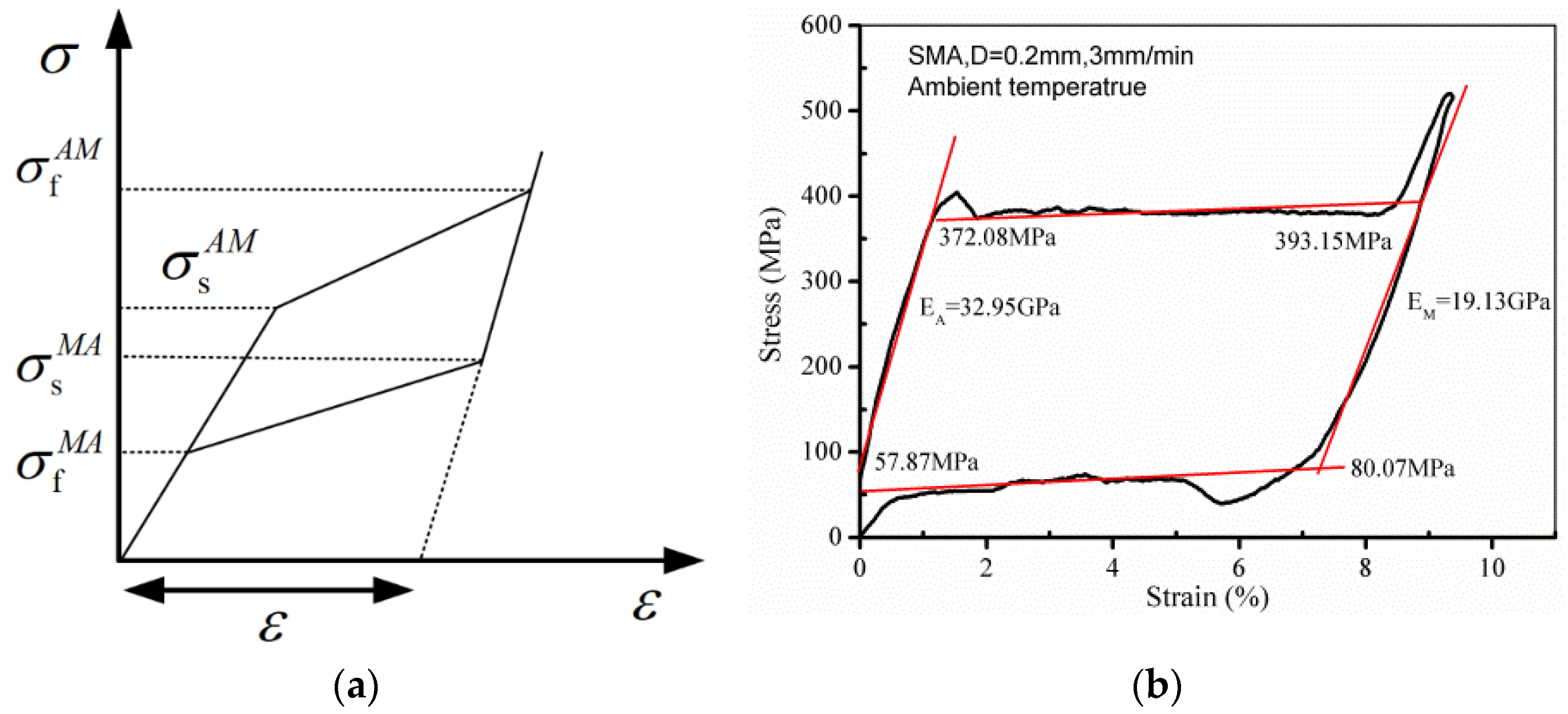


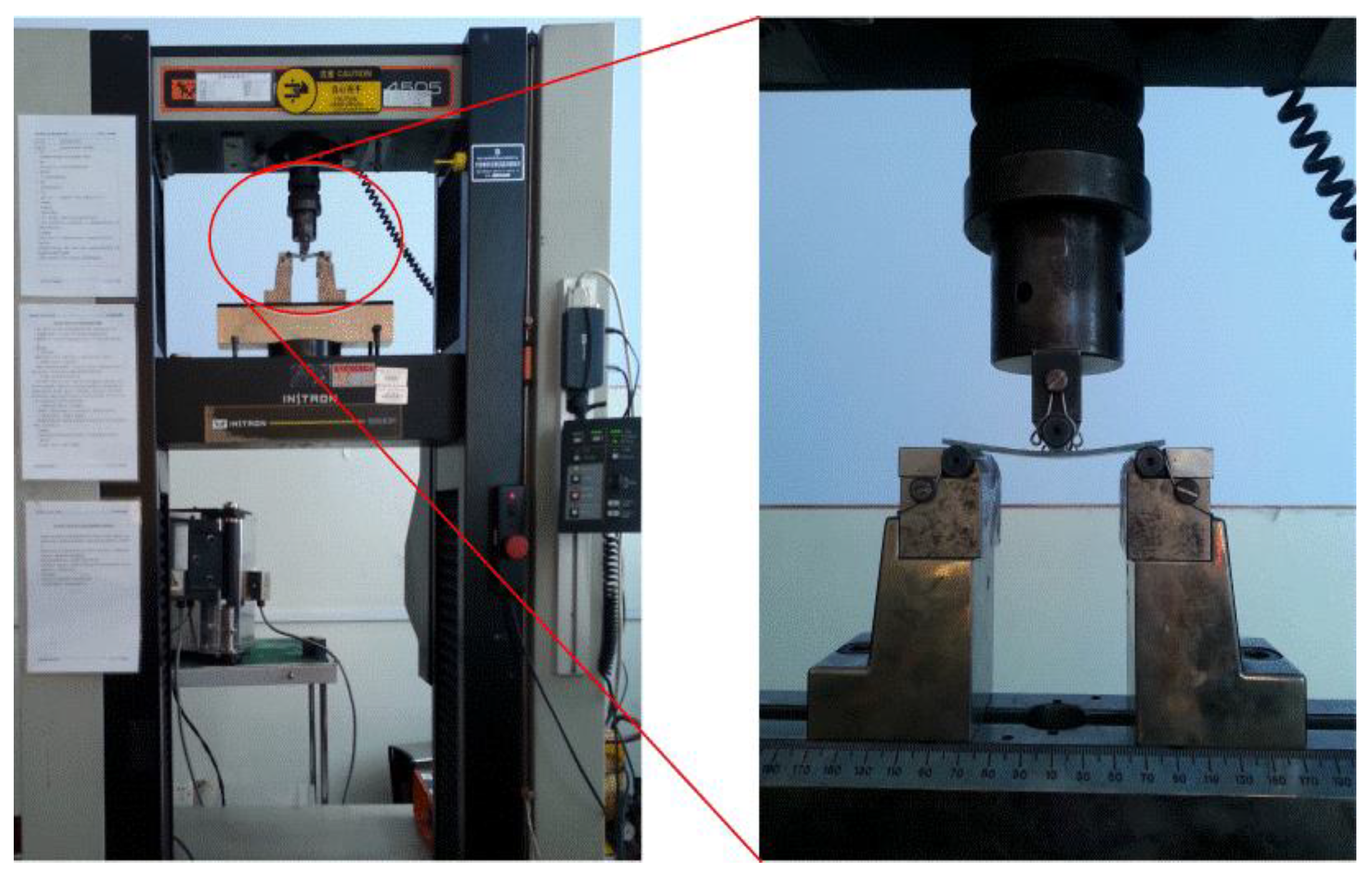
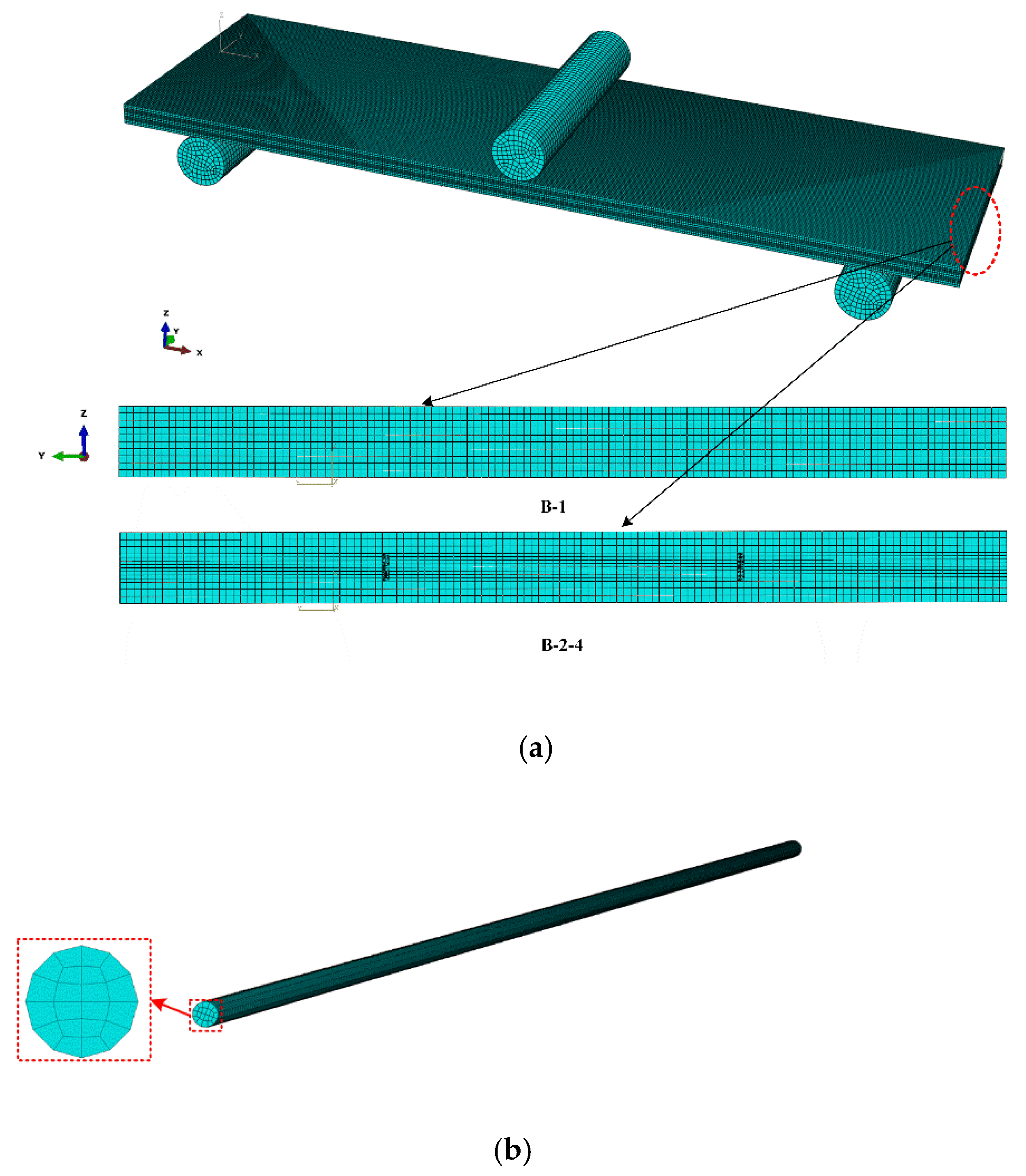
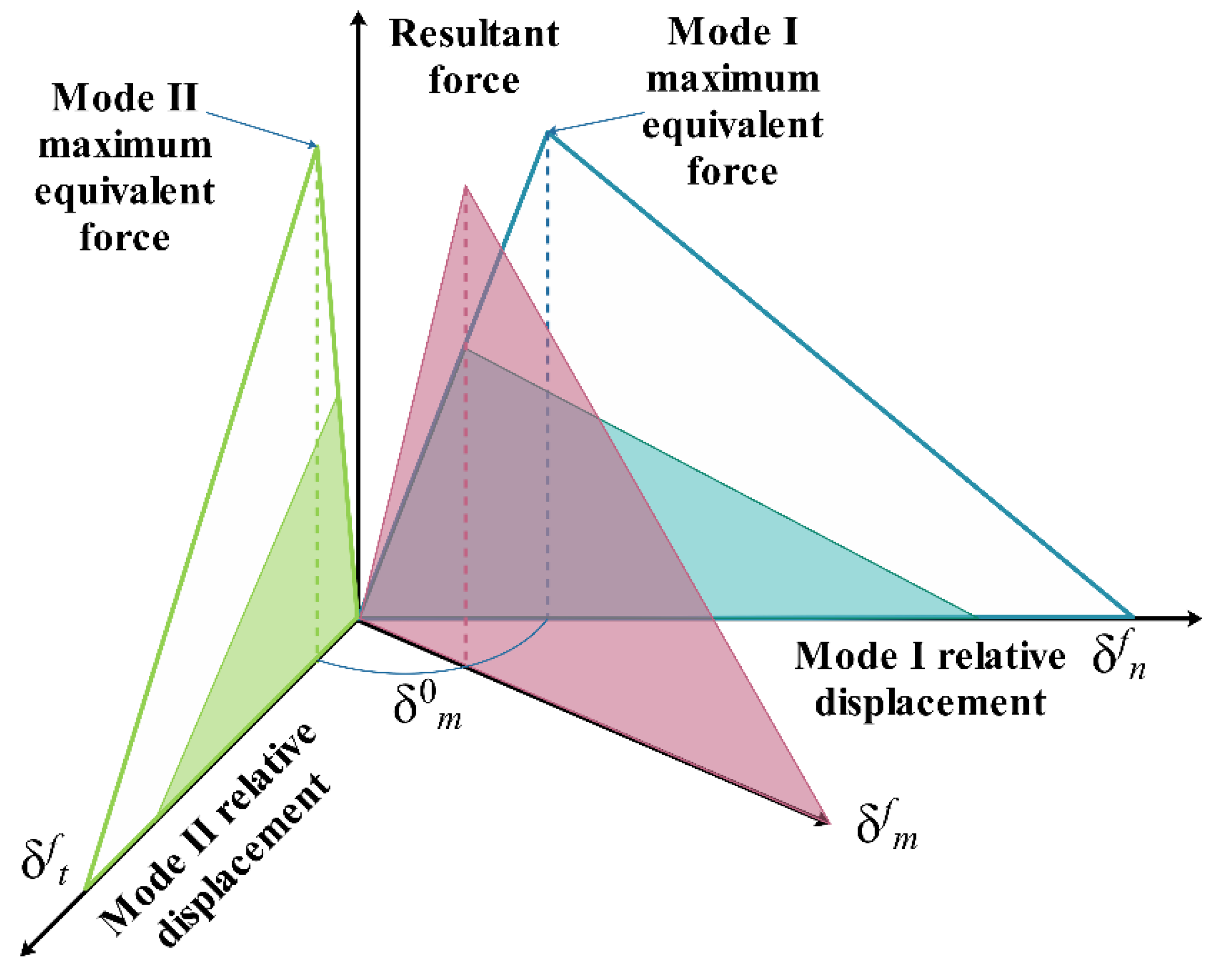
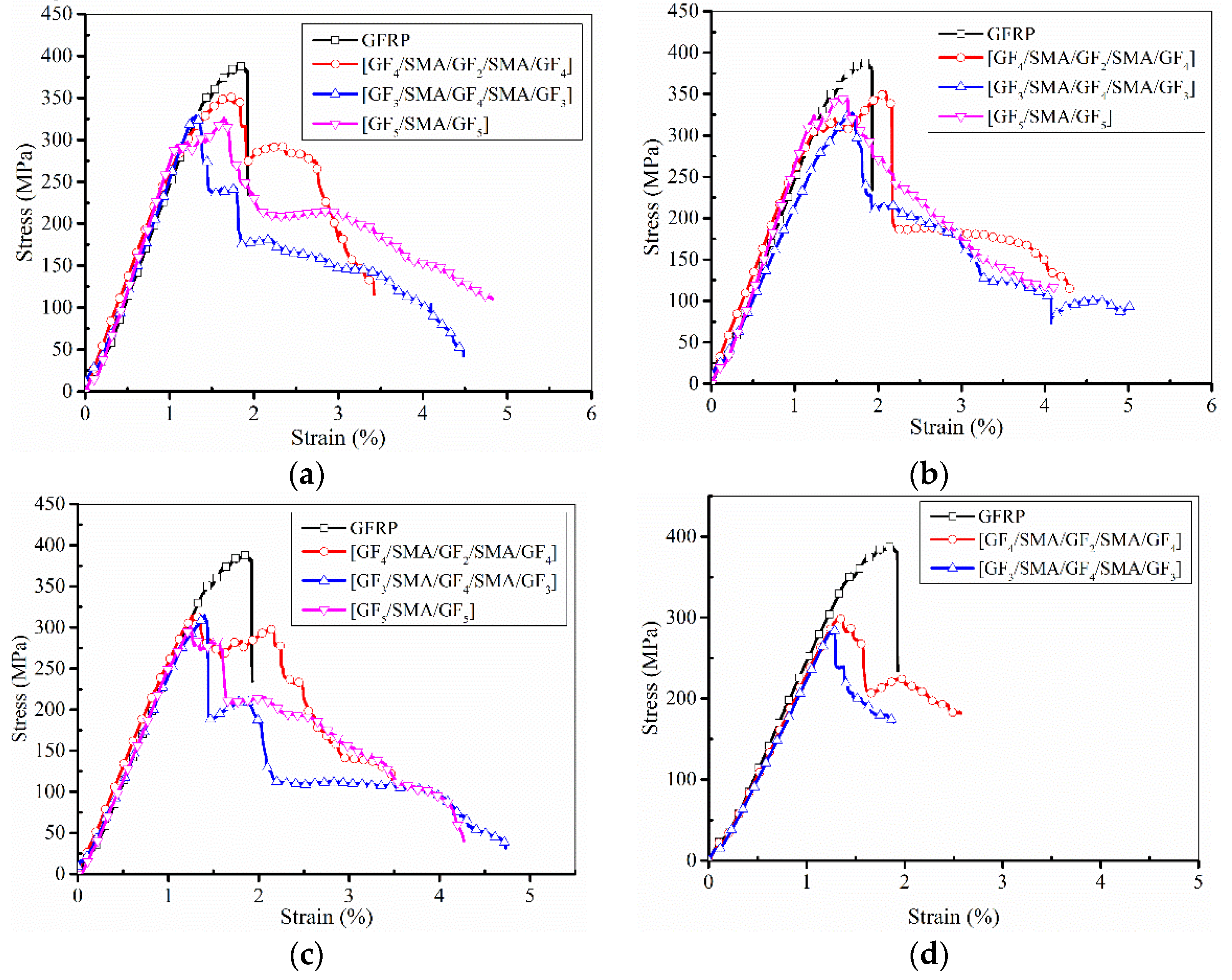
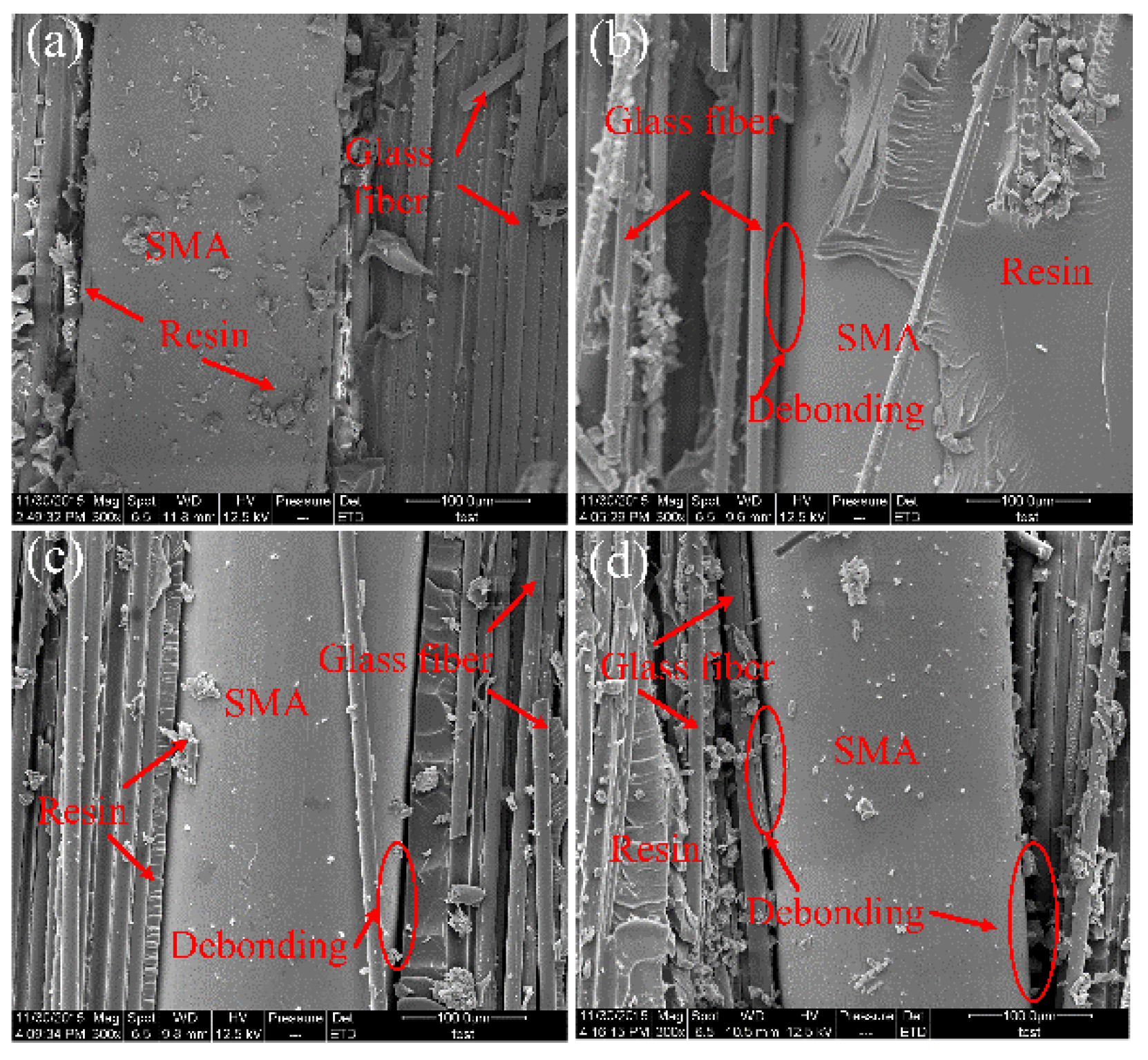
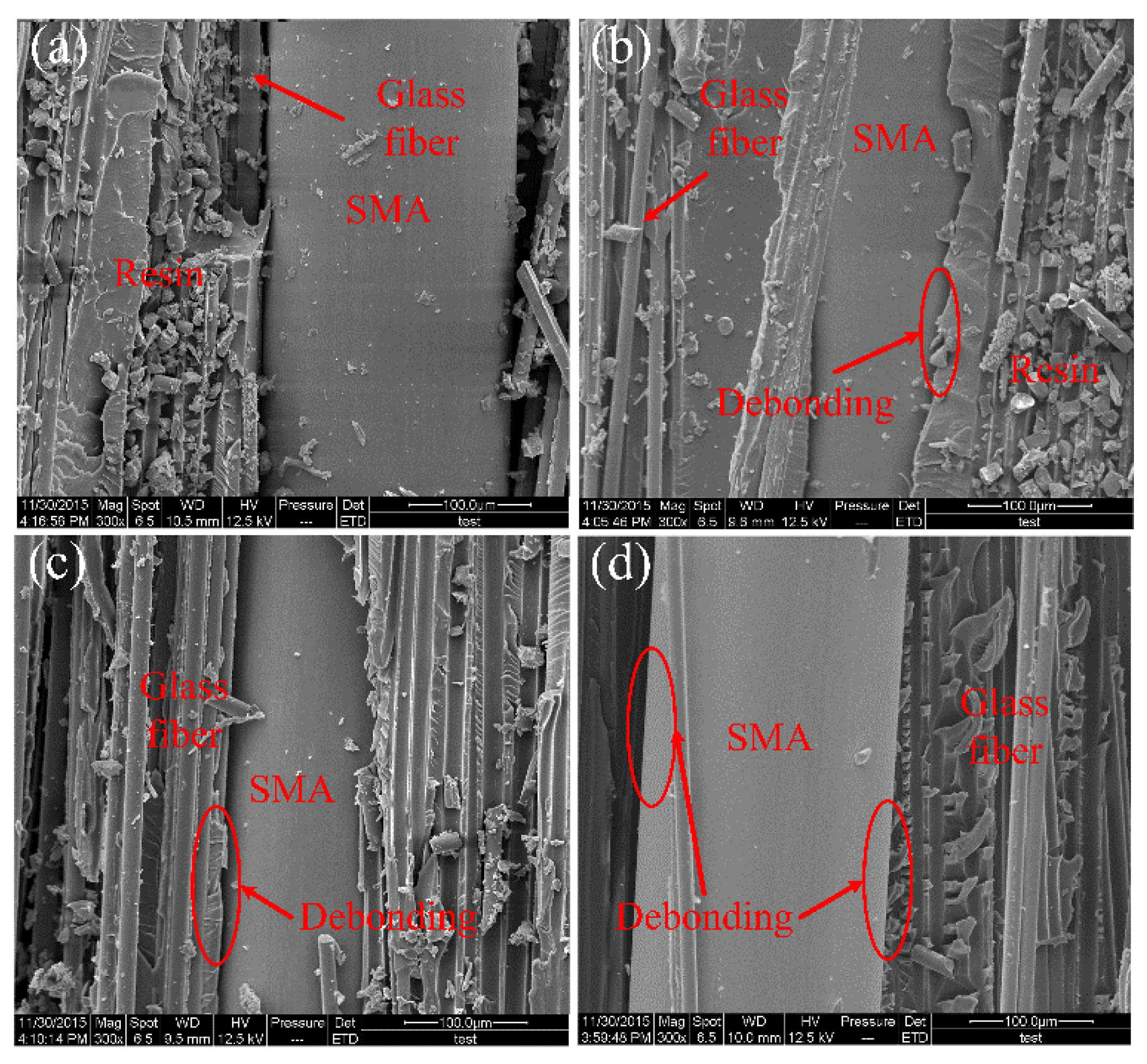
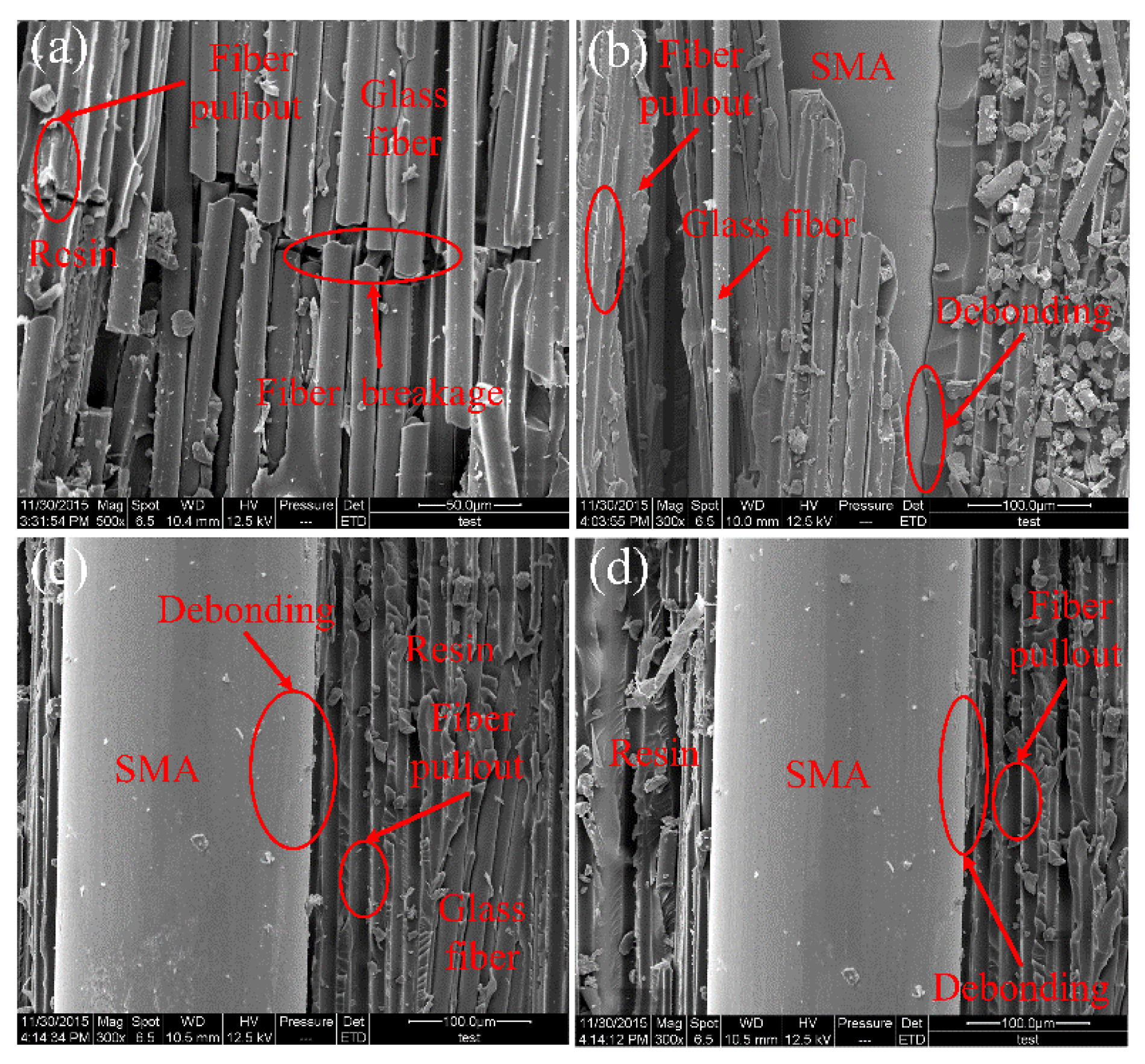


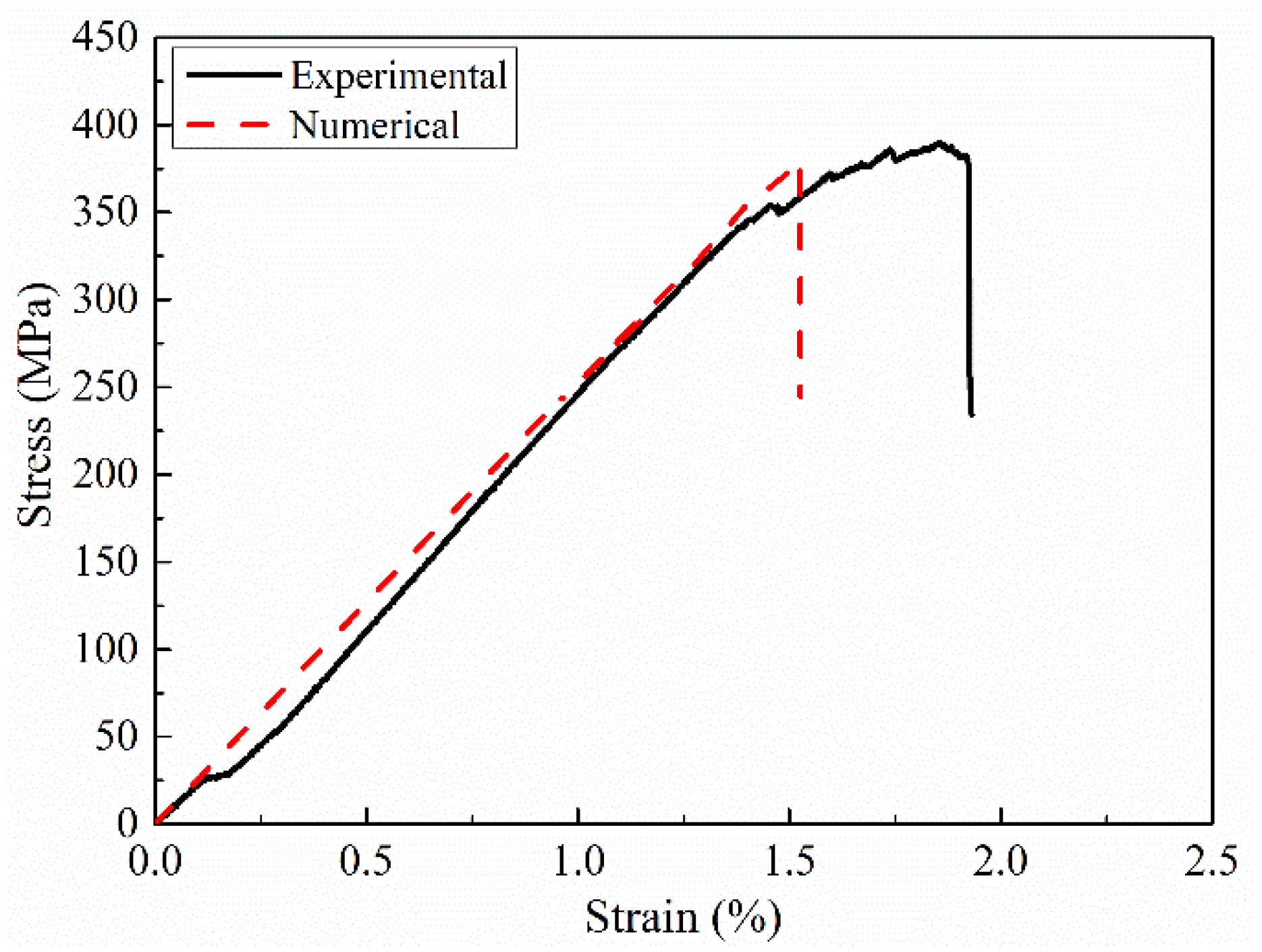
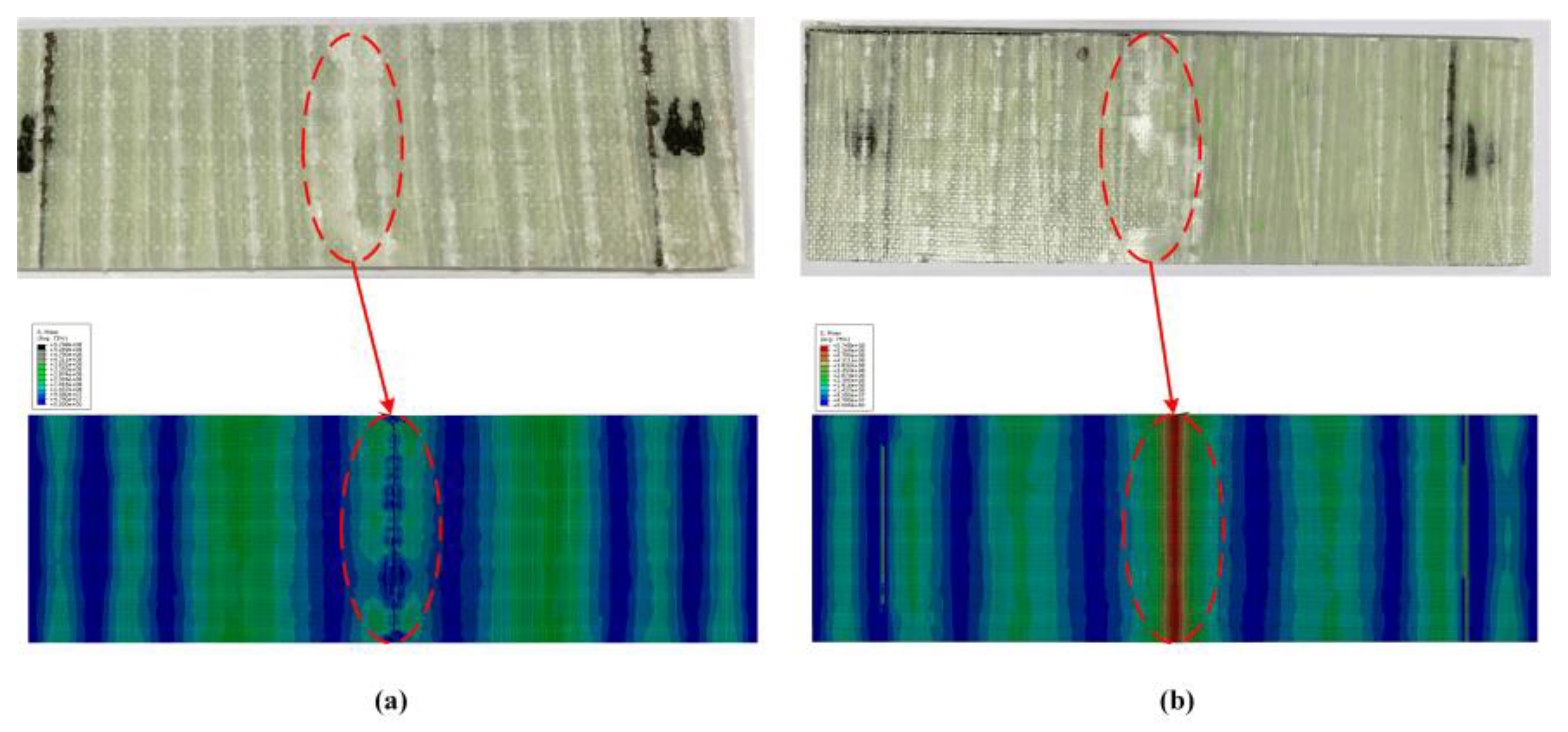



| Material Parameter | Martensite | Austenite |
|---|---|---|
| Phase transformation stress (MPa) | = 393.15, = 372.08 | = 57.89, = 80.07 |
| Phase transformation strain (%) | ε = 0.94, ε = 9.41 | ε = 7.09, ε = 0.35 |
| Elasticity modulus (GPa) | = 19.13 | = 32.95 |
| Tensile strength (MPa) | 1115.26 | |
| Failure strain (%) | 12 | |
| Specimen | Number |
|---|---|
| [GF10] | B-1 |
| [GF4/SMA/GF2/SMA/GF4] | B-2-2/4/6/10 |
| [GF3/SMA/GF4/SMA/GF3] | B-3-2/4/6/10 |
| [GF5/SMA/GF5] | B-4-2/4/6 |
(GPa) | (GPa) | (GPa) | (GPa) | ||
| 24.43 | 7.11 | 0.3 | 0.34 | 6.34 | 1.41 |
(MPa) | (MPa) | (MPa) | (MPa) | (MPa) | (MPa) |
| 666.44 | 320.44 | 70.8 | 188.9 | 51.7 | 51.7 |
| Specimen | Number | 0 | 2 | % | 4 | % | 6 | % | 10 | % |
|---|---|---|---|---|---|---|---|---|---|---|
| B-2 | Modulus (GPa) | 22.73 | 23.81 | 23.91 ↑ | 22.42 | 22.11 | ||||
| ± 0.37 | ± 0.4 | 4.75 | ± 0.35 | 5.19 | ± 0.41 | −1.32 | ± 0.31 | −2.73 | ||
| Strength (MPa) | 391.74 | 368.86 | 369.17 | 318.73 | 309.23 | |||||
| ± 6.94 | ± 6.5 | −5.84 | ± 5.2 | −5.76 | ± 6.4 | −18.63 | ± 6.9 | −21.06 | ||
| B-3 | Modulus (GPa) | 22.73 | 23.61 | 23.73 ↑ | 22.38 | 21.66 | ||||
| ± 0.37 | ± 0.39 | 3.87 | ± 0.35 | 4.40 | ± 0.42 | −1.54 | ± 0.32 | −4.71 | ||
| Strength (MPa) | 391.74 | 334.67 | 342.57 | 316.68 | 289.40 | |||||
| ± 6.94 | ± 4.14 | −14.57 | ± 4.56 | −12.55 | ± 6.51 | −19.16 | ± 5.82 | −26.12 | ||
| B-4 | Modulus (GPa) | 22.73 | 22.74 | 23.74↑ | 22.21 | - | ||||
| ± 0.37 | ± 0.3 | 0.04 | ± 0.32 | 4.4 | ± 0.31 | −2.89 | ||||
| Strength (MPa) | 391.74 | 349.69 | 313.85 | 304.95 | - | |||||
| ± 6.94 | ± 5.35 | −10.73 | ± 4.2 | −19.88 | ± 6.1 | −22.16 |
Publisher’s Note: MDPI stays neutral with regard to jurisdictional claims in published maps and institutional affiliations. |
© 2022 by the authors. Licensee MDPI, Basel, Switzerland. This article is an open access article distributed under the terms and conditions of the Creative Commons Attribution (CC BY) license (https://creativecommons.org/licenses/by/4.0/).
Share and Cite
Xu, L.; Zhao, J.; Zhang, X.; Shi, M.; Wang, Z. Finite Element Analysis of Flexural Behavior of Shape Memory Alloy Hybrid Composites Laminates. Polymers 2022, 14, 5268. https://doi.org/10.3390/polym14235268
Xu L, Zhao J, Zhang X, Shi M, Wang Z. Finite Element Analysis of Flexural Behavior of Shape Memory Alloy Hybrid Composites Laminates. Polymers. 2022; 14(23):5268. https://doi.org/10.3390/polym14235268
Chicago/Turabian StyleXu, Lidan, Jitao Zhao, Xiangyu Zhang, Mingfang Shi, and Zhenqing Wang. 2022. "Finite Element Analysis of Flexural Behavior of Shape Memory Alloy Hybrid Composites Laminates" Polymers 14, no. 23: 5268. https://doi.org/10.3390/polym14235268
APA StyleXu, L., Zhao, J., Zhang, X., Shi, M., & Wang, Z. (2022). Finite Element Analysis of Flexural Behavior of Shape Memory Alloy Hybrid Composites Laminates. Polymers, 14(23), 5268. https://doi.org/10.3390/polym14235268





